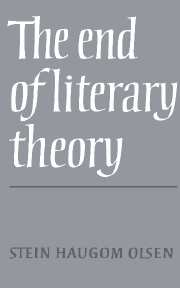Book contents
- Frontmatter
- Contents
- Preface
- Literary aesthetics and literary practice
- Interpretation and intention
- Authorial intention
- Text and meaning
- The ‘meaning’ of a literary work
- Defining a literary work
- What is poetics?
- On unilluminating criticism
- Criticism and appreciation
- Value-judgements in criticism
- Literature, fiction, and reality. A problematic relationship
- Thematic concepts: where philosophy meets literature
- Literary theory and literary aesthetics
- Notes
- Bibliography
- Index
Authorial intention
Published online by Cambridge University Press: 05 November 2011
- Frontmatter
- Contents
- Preface
- Literary aesthetics and literary practice
- Interpretation and intention
- Authorial intention
- Text and meaning
- The ‘meaning’ of a literary work
- Defining a literary work
- What is poetics?
- On unilluminating criticism
- Criticism and appreciation
- Value-judgements in criticism
- Literature, fiction, and reality. A problematic relationship
- Thematic concepts: where philosophy meets literature
- Literary theory and literary aesthetics
- Notes
- Bibliography
- Index
Summary
ONE
The framework for the debate on authorial intention which was provided by Wimsatt and Beardsley in the article on ‘The Intentional Fallacy’, which they wrote more than thirty-five years ago, has proved to be a lasting one. The strong influence of this article has unfortunately not only been for good. It clearly said much that was right and essential, but like any other article it was a product of its time and it embodied a few of the confusions in current philosophical debate at that time. Because of the very strong hold this article has had on the minds of literary theorists nobody has really managed to break through the framework of suppositions on which it rested, and it has therefore tended to prevent new developments in the debate on authorial intention in a period where philosophical debate on other aspects of intentional behaviour wholly changed character. The result of this has been that while a part of Wimsatt and Beardsley's argument has become an accepted commonplace, another side of the problem has remained in partial obscurity. To see whether this latter part of the problem has any bearing on Wimsatt and Beardsley's conclusions about what evidence is relevant in establishing critical conclusions it must be re-examined in the light of some of the recent literature on communication intention in philosophy. It is the purpose of this article to sort out the confusion of two different problems dealt with in ‘The Intentional Fallacy’ and tentatively to examine the problem of authorial intention again.
- Type
- Chapter
- Information
- The End of Literary Theory , pp. 29 - 41Publisher: Cambridge University PressPrint publication year: 1987
- 2
- Cited by



